Table of Contents
What is Naya Maverick?
Best performances by Naya Maverick
Naya Maverick Gameplay
What’s the reason to splash red in Maverick?
Cards currently being tested out in Naya Maverick
What’s a good starting build for Naya Maverick?
What to look for in an opening hand with Naya Maverick
Naya Maverick’s History
Naya Maverick FAQ
Other Resources
A quick shout out to Ben [Kvellish on Discord] for the insane amount of work they put into helping with updating this primer.
Also to Mark Strassman [StrassDaddy on Discord] for his ongoing support of the deck, no matter the meta-based obstacles put in front of him. This guy is the face of Punishing / Naya Maverick and for good reason.
Make sure you follow him on Twitch and look out for his YouTube content!
Thank you both for making the Maverick community as good as it is in 2024.
What is Naya Maverick?
Naya Maverick (also referred to as Punishing Maverick) is the archetype that splashes red, typically for removal and spell-based effects like Pyroblast & Red Elemental Blast. Minsc & Boo has been a successful addition and a strong reason why players have had success with the Naya take on Maverick.
Previous card choices that made Naya Maverick so strong are either banned (Wrenn and Six) or no longer viable or as strong as they once were (Punishing Fire, Klothys). We are here now to take a look at Naya Maverick in early 2023 as it fights the Initiative beast while continuing to fend off Delver and combo decks. The card choices have changed in many places, but the rationale behind them has stayed consistent – play problematic creatures and lands through either Green Sun’s Zenith or Knight of the Reliquary in order to provide time for strong, fair cards to take over.
Best performances by Naya Maverick
2023 | SCG Baltimore 10K 5th Place | Harry Hackett
2023 | SCG Baltimore 10K 11th Place | Mark Strassman
2022 | MTGO Legacy Challenge 6th Place | PhilLesh
2022 | The Legacy Pit Open II 4th Place | Harry Hackett
2022 | SCG CON Baltimore – Legacy $5K 10th Place | Tyrik Strachan
Naya Maverick Gameplay
What’s the reason to splash red in Maverick?
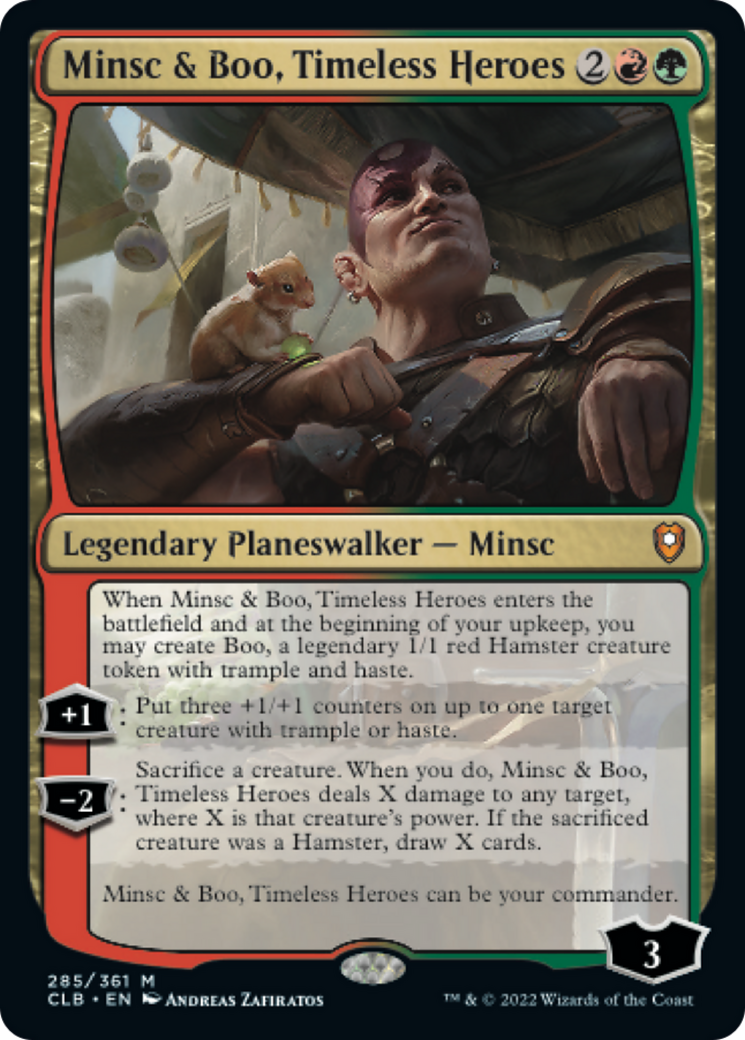
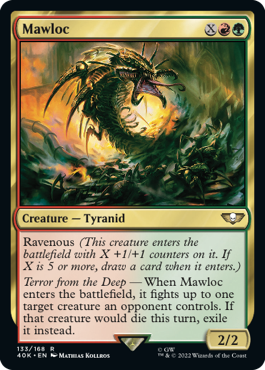
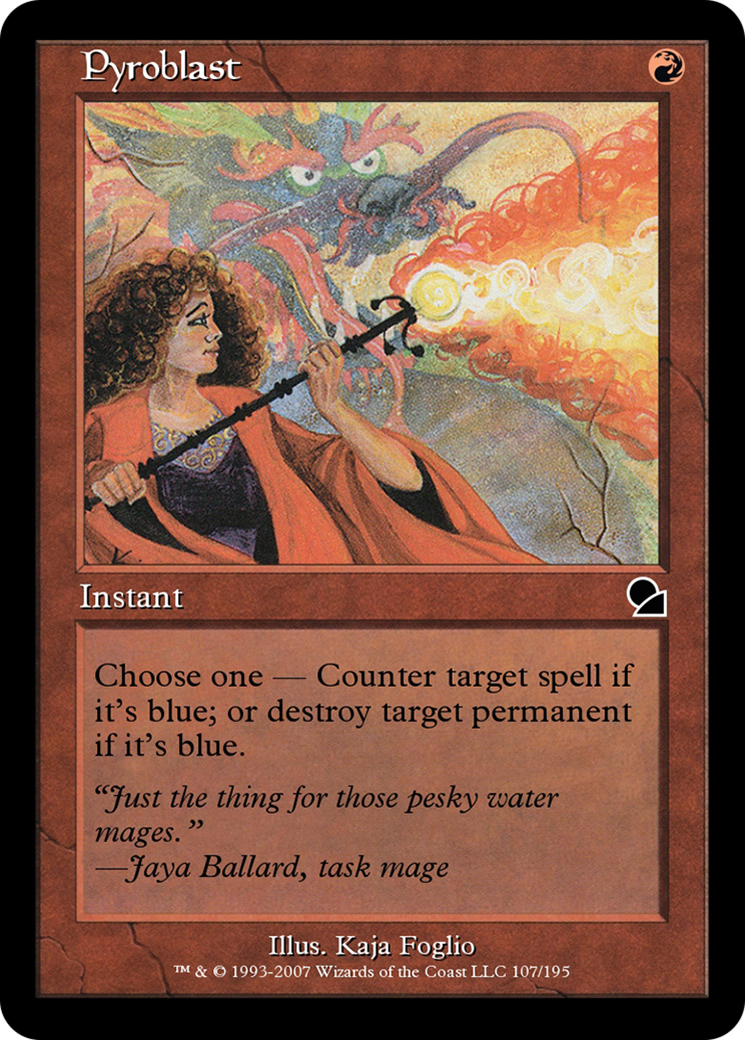
Maverick has, as time forces it to do, adapted to emerging threats within the legacy metagame. Time and again, Wizards has shaken up the format, for better or worse. In some cases, cards are just designed too strong (looking at you, Oko). In most cases, however, the cards are designed without legacy in mind. A format with such a massive pool of available cards is bound to have some amount of problematic interactions.
Minsc has added a real threat to the deck, one that provides ongoing pressure and sometimes an ‘I-Win’ button with its throw ability.
Mawloc has been a huge boost to the Green Sun’s Zenith package. It providers early removal or late game dominance as an ‘Endless One’ style threat that can even replace itself.
Blasts are always going to be relevant in the format where blue decks shine, but it’s even more appealing when one of the biggest threats in the format is blue (Murktide).
Enjoy this content? Consider becoming a GreenSunZenith Patron!
Cards currently being tested out in Naya Maverick
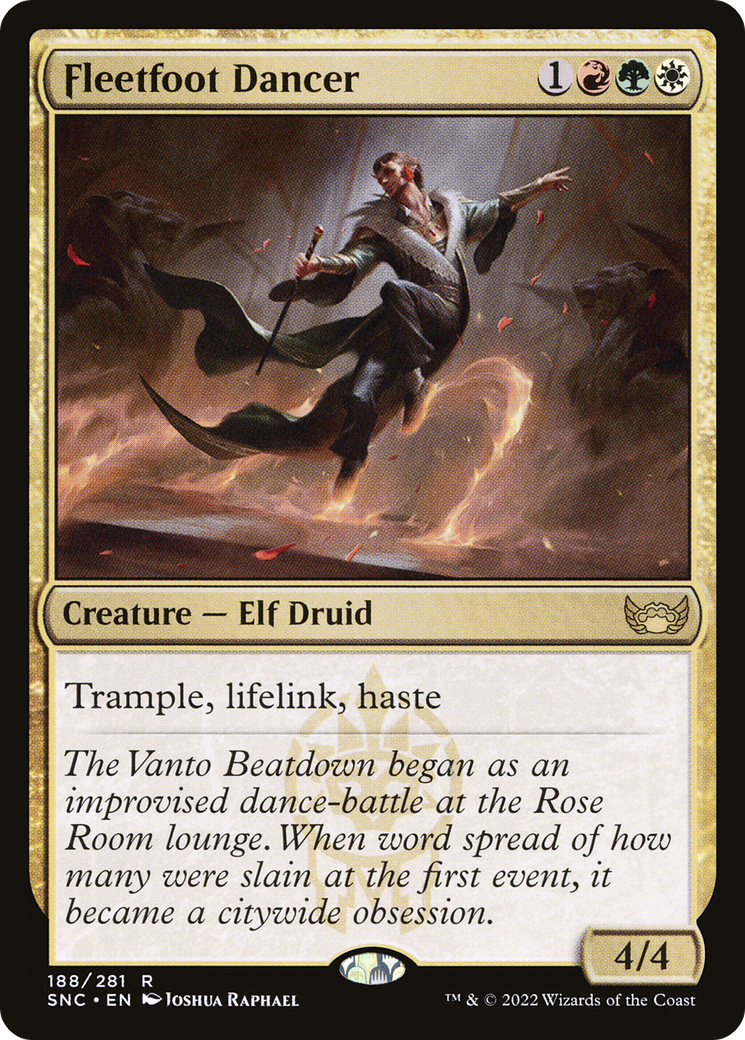
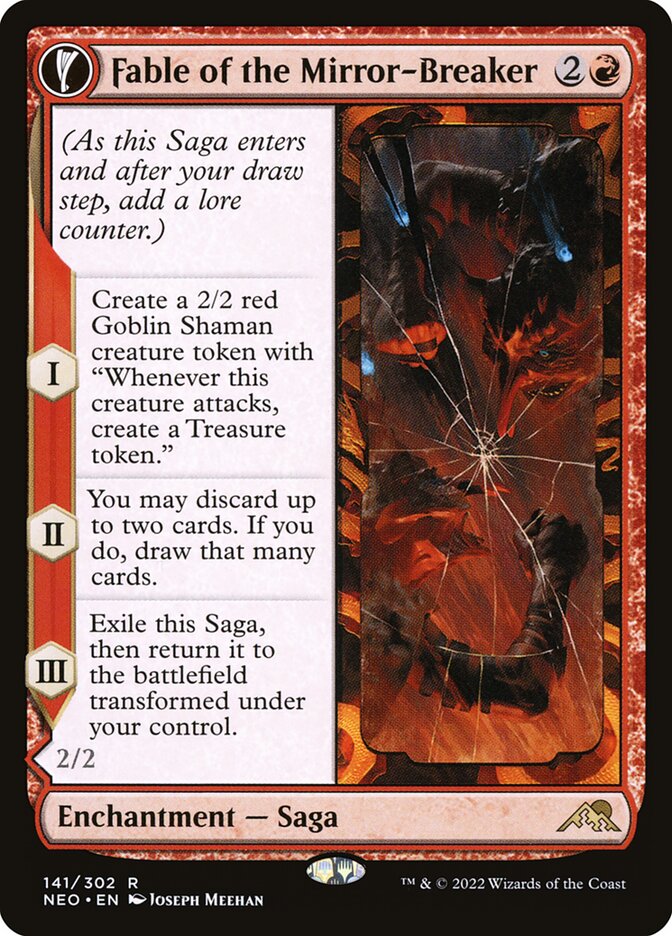
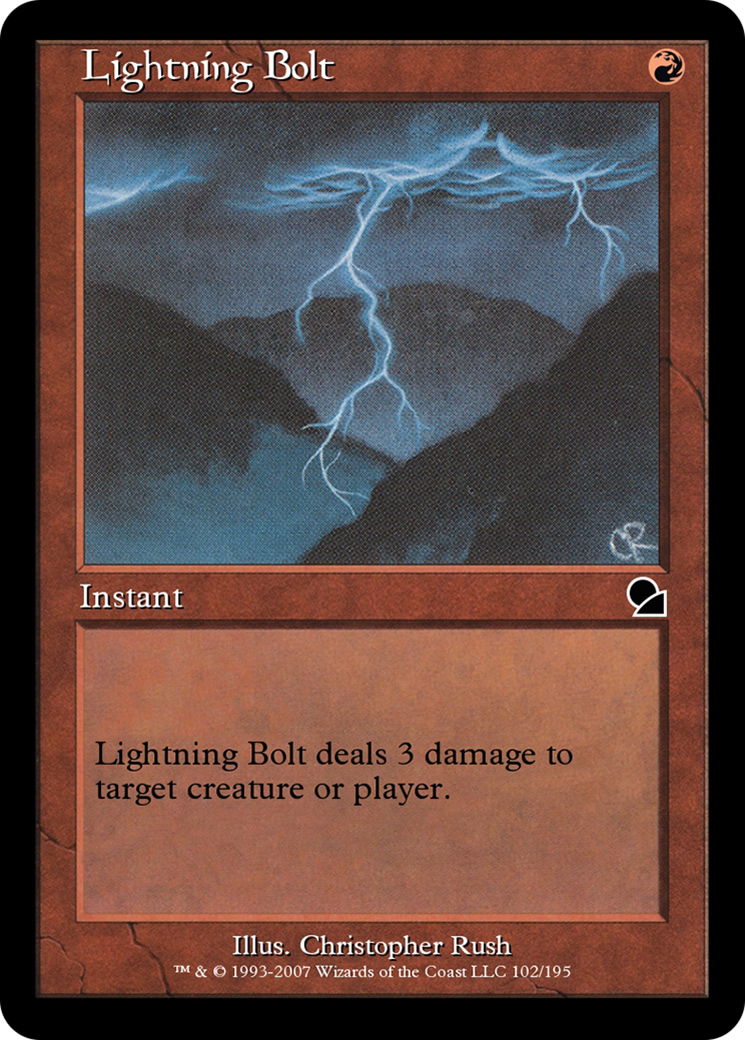
Fleetfoot Dancer
Fleetfoot was a card I was recommended in a list by ThatMaverickJoe. In a current metagame where both combat damage and dealing combat damage are relevant, haste and lifelink are fantastic.
You need your threats to have immediate impact and Fleetfoot alongside Questing Beast do just that. Stealing the Initiative and gaining 4 is huge when factors of 3 are crucial vs Delver.
Lightning Bolt
Bolt has been a great replacement for Punishing Maverick as it deals with the real threats in the format right now. Most of the time, DRC is a 3/3 and WPA can be answered early on via a Bolt.
Bolt when paired with Swords to Plowshares means you have more ways to deal with creatures in the early turns, allowing you to pressure your opponents with exalted creatures.
Bolt has been fantastic, the 3 damage for 1 mana in my opinion has outweighed the ongoing value you gain from Punishing Fire and Grove of the Burnwillows.
Fable of the Mirror Breaker
Fable is card selection, something Maverick rarely has access to. It allows you to trade away irrelevant cards like Collector Ouphe against Elves, for hopefully more relevant pieces like removal.
Fable also creates ongoing value, allows you to ramp in the early turns and can cause some serious issues if it isn’t dealt with once flipped and online.
Thanks to mana dorks, Fable is something we can get online from as early as turn 2 making it even more appealing.
What’s a good starting build for Naya Maverick?
The traditional Maverick manabase has remained consistent, excluding a couple slots. Below is the skeleton manabase, which will be the foundation for the lists following.
From there, we add the cards that are considered mainstays within the archetype. These are the creatures, removal, and utility that the deck uses to function. Some of my views on the strength of cards may be present, but those views are formed over months of testing and gameplay within the format.
This shell is relatively familiar. Exact numbers and cards can change, but we will look at the choices individually to understand their inclusion.
4 Green Sun’s Zenith
This is the core of the deck. While there are other Zenith decks in the format, none do it as well as Maverick. Green Sun Zenith for X=0 fetches a Dryad Arbor for effectively 8 copies of turn 1 acceleration. Beyond that is when it shines. Finding problematic creatures, utility, or removal can completely change the game.
4 Swords to Plowshares
This is the premier removal in white. Nothing does it better.
4 Mana Dorks
Mana dorks (including Dryad Arbor) form the foundation of this deck. Our goal is to either play cards ahead of their curve or force our opponents to stumble as we push through via accelerated mana.
3 Thalia, Guardian of Thraben/Ethersworn Canonist
Hatebears are a mainstay in this archetype. Traditionally, Thalia has been the go-to. However, with the rise of creature-based strategies in the various Initiative lists and the use of go-wide strategies to combat it, Thalia can feel weak. This is why I advocate for Ethersworn Canonist as an alternative. Not only does it equally tax combo strategies, it also hurts the go-wide strategies like Elves and Food Chain Goblins. It can be more dead in some matchups, but win much harder in others.
2 Endurance
Endurance is our catch-all to graveyard-based strategies. We generally want 4-5 answers to them within our 75. Endurance solves this as both a turn 0 answer to combo and a respectable 3/4 body as early as turn 2. The lost card advantage to pitching it is almost always welcome, as doing so can prevent the opponent from winning on the spot.
1 Collector Ouphe
Collector Ouphe is another Modern Horizons card that has given life to this deck in the current format. Artifact-based strategies struggle in the face of Collector Ouphe because it is either shuts them down entirely or forces much slower play patterns. It is not always a must-have in the main deck, but sans knowledge of the meta, it is a safe consideration as it has some effect in almost every matchup.
1 Qasali Pridemage/Outland Liberator/Knight of Autumn
Qasali Pridemage can be easily swapped for Outland Liberator, as they fulfil very similar roles. In many cases, Outland Liberator is the stronger choice. There are two reasons I have chosen to include Qasali Pridemage within this shell. First, it pitches to both Endurance and Solitude, if you choose to play the latter. Second, keeping track of Day/Night can be cumbersome, especially after Outland Liberator has left the battlefield. Another optional consideration is Knight of Autumn.
1 Ramunap Excavator
Ramunap Excavator is a Green Sun Zenith-able Crucible of Worlds. In a deck where Wasteland serves as a viable strategy to disruption, recursion is gravy.
4 Knight of the Reliquary
While not as strong as it was 8 years ago, Knight of the Reliquary still forms the other half of the basic glue that holds this deck together. Numbers can certainly shift here, from 2-4 copies as space permits. However, there is very little that scoffs at a 10/10 Knight.
4 Mawloc
I have included a new card from Warhammer 40k in this shell, Mawloc. Simply put, this is the most versatile creature we can play. In many players’ lists, it has completely replaced Punishing Fire. Not only does it play as a Green Sun’s Zenith targeted removal, but it is a scalable creature into the later stages of the game. While it may be used to remove a Stoneforge Mystic or Dauthi Voidwalker early, it can also be as large as you can make it later on.
2 Minsc & Boo, Timeless Heroes
This is probably the strongest 4-mana planeswalker in Legacy. It creates a threat every turn, provides removal and card advantage, and wins the game alone if unanswered immediately.
From this shell, we begin to add our unique flavours.
There are a few different routes to achieve this objective. In particular, we will examine the use of Urza’s Saga, Stoneforge Mystic, and traditional Taxes lists as the three main ways to establish a fair board state and begin taking control. Generally, these lists do not overlap much, as they take up competing slots within the shell, though they may overlap by forgoing other common strategies.
Urza’s Saga
Urza’s Saga within Maverick provides a couple fundamental advantages. First, it provides consistency through token generation and tutoring. Second, it provides a unique toolbox of hate and utility pieces for a variety of scenarios. Finally, it provides virtual card advantage, which can be crucial against control decks. Let’s look at both the card choices and a sample shell.
Urza’s Saga
Numbers here very upon a few things – the number of targets desired, the amount of space within the deck, and the likelihood that Blood Moon will make them effectively useless. Each target below also grows the tokens.
Haywire Mite
Like Qasali Pridemage/Outland Liberator/Knight of Autumn above, Haywire Mite is excellent removal tutorable through Urza’s Saga. Notably, it does not hit creatures, but does exile. This matters for cards like Kaldra Compleat and recurable threats such as those in Painter combo lists.
Shadowspear
Trample and lifelink are both abilities that many of our creatures desire. While the second ability does have uses, we usually care much more about the stats provided.
Soul-guide Lantern
This serves as additional graveyard hate that notably does not target our opponents. It can also cycle itself if there is no graveyard strategy of note.
Pithing Needle
There are very few cases where Pithing Needle is a completely dead card. When it is good, it can shut down entire strategies. In many cases, naming a single card can cause opponents to stumble enough for our threats to do what needs to be done.
Pyrite Spellbomb
While this card has fallen out of favour given current threats, it can be used to answer Mother of Runes and various x/2 threats.
Currency Converter
This card is generally too slow in our deck to provide the value we would like. However, in some cases, it does a very good job of mitigating strategies. If you expect to see Pox or other mono-black discard strategies, Currency Converter can reward foresight.
Stoneforge Mystic
Stoneforge Mystic provides tutorable options much the same way as Urza’s Sage. The difference is generally the strength of the target. While Saga provides some custom answers to specific threats, Stoneforge Mystic provides a more “nuclear option.” While she is vulnerable for a turn, a single activation of Stoneforge Mystic can be all that is required to create the inevitability of victory.
Shadowspear
In addition to Urza’s Saga, this can be found through Stoneforge Mystic.
Umezawa’s Jitte
Umezawa’s Jitte provides utility in creature matchups that no other equipment can compete with. Pump and removal in one that can gain life in a pinch, this card can swing many board states from abysmal to favoured.
Kaldra Compleat
As a living weapon, Kaldra is a must-answer threat this is surprisingly hard to answer – both the creature and the equipment are indestructible. In many cases, simply “Kaldra checking” an opponent can end the game. If they cannot answer it within a turn, they are likely to succumb to its aggression.
Batterskull
While generally worse than Kaldra Compleat, there are cases where Batterskull is preferred. It provides life gain, which can be very valuable in some situations. If you believe that the germ is going to be removed, Batterskull is much easier to either equip or redeploy because of both the lower equip cost and it’s secondary ability, which pairs nicely with the Stoneforge Mystic.
Sword of Fire and Ice
SoFI provides unique protection against Delver that no other equipment can. Additionally, it provides removal and card advantage. While not included in lists as often as the equipment above, SoFI should not be forgotten.
Raw Power
Finally, we have the option to provide strength through the raw power of cards. In this case, we are generally maximizing the strength of our creatures to ensure a consistently fast clock that can back up the traditional taxes. Currently, a strong candidate for this is including the Initiative into the deck. While we cannot match the speed of dedicated Initiative strategies, we continue to provide the utility that they cannot.
White Plume Adventurer/Seasoned Dungeoneer/Undermountain Adventurer
The initiative is a very strong mechanic in 1v1 magic, especially in Legacy as there is no singleton rule in deck construction to mitigate the strength with more variance. At the time of writing, there are calls for bans, but no action has been taken. The strength and consistency of The Undercity has changed both Legacy and Vintage in ways that few unique mechanics have in the past.
Mother of Runes
There simply isn’t room in many lists for Mother of Runes. However, this does not say anything to her strength as utility. Some lists have forgone tax creatures to include Mom. When not focusing on Saga or Stoneforge Mystic, Mom gets higher priority.
Scryb Ranger
This creature pairs best with Mother of Runes. As with Mom, Scryb Ranger raises in priority in the more vanilla strategies.
Scavenging Ooze
Scooze can play well as graveyard hate, but many lists have chosen to use Endurance instead. However, if you do not plan on holding mana to use Urza’s Saga or Stoneforge activations, having an outlet for it can be well-placed.
Questing Beast
Questing Beast gains additional lines of text each time you read it. It pairs well with Minsc & Boo and can ignore some blockers, such as thopters from 8cast or True-Name Nemesis from Delver.
Titania, Protector of Argoth
5-mana cards are rare in Legacy, but Titania can do one thing well if she’s allowed to come down. She swarms the board with tokens, as the deck is excellent at sacrificing lands.
List by Jonatan piloted to a Top8 finish at the Four Seasons League Tournament – Legacy 2.5k at Alara Games, Sweden.
Have fun playing Fair Magic -Ben (Kvellish)
A HUGE thank you to Ben for putting together this deck-tech for their take on building Naya Maverick. It would have taken a considerable amount of time to put this together and I really appreciate the effort you can easily see above.
Here’s a list that I’ve been playing in paper recently and really enjoying, taking advantage of Mawloc in a creature-heavy metagame.
My current paper Naya Maverick 75 🔥
Local meta is heavily creature-based so Bolts help vs WPA, DRC and finishing off opponents 💥
Mawloc has been great since day 1 🏆
Verdant should be Foothills #3Blasts are just too strong to move back to Abzan right now 💀#MTG #MTGLegacy pic.twitter.com/5TSL5kbi42
— DougesOnTwitch🎥 (@DougesOnTwitch) February 10, 2023
What to look for in an opening hand with Naya Maverick
Generally with Maverick you’re looking for a few things. Mana acceleration is great, removal in your opening and some sort of play vs combo.
Let’s use the list above from Ben to put together a few hands and see if we’d keep them.
Hand 1

This hand is great against any creature based deck. You have all the mana you need so you don’t necessarily need to Green Sun’s Zenith for Dryad Arbor right away.
If you’re up against a combo deck, you may want to keep that GSZ for Collector Ouphe.
This can be a bit of a feast or famine hand depending on your matchup in the blind, but I don’t think I’d mulligan it due to being able to cast all your spells and have some flexibility in Green Sun’s Zenith.
Hand 2

Honestly just a great hand. You have Noble to ramp into two options. Green Sun’s Zenith for Collector Ouphe if you feel like you’re up against combo. Mawloc and potentially Wasteland in the same turn to completely reset your opponent.
The second Mawloc is fantastic as we’ve started with some mana acceleration, meaning this creature could not only be out of bolt range as early as turn 3, but also take out another creature from your opponents side.
Hand 3

A pretty honest hand, but one I’d be happy to keep. We have interaction in Wasteland and Swords to Plowshares, mana acceleration in both Birds and Hierarch, and Green Sun’s Zenith to find what we need once our opponent shows what they are on.
We also have all colours online with our manabase. Honestly this hand is up there was near perfect, potentially the 2nd mana dorks taking the same of a threat to make it chef’s kiss.
Hand 4

We found our first mulligan! Too many lands, spells a little too situational for my liking (only good against creature decks). Another land off the top would spell disaster for us and thankfully Maverick mulligans quite well. Let’s have a look at a 6.

Alright we have a keep, the question is what would you put back?
I’m actually not going to answer this one and leave it up to you. If you’d like to comment below and let me know your answer that would be great.
You could also share this article on Twitter with your answer and tag me in it.
Naya Maverick’s History
Seraphix had a great post on MTGTheSource going over some of the initial reasoning for Punishing Maverick.
“The innocuous synergy between Grove of the Burnwillows and Punishing Fire was initially discovered in Extended. It has since become apparent that the theoretically infinite supply of Shocks granted by this combination is extremely potent in Legacy. Here is how Punishing Fire lines up against creatures in the current Legacy metagame.
Punishing Fire was first adopted in Maverick decks at the end of 2011, primarily as a way of gaining an edge in the Maverick mirror. It turns out that the Punishing Fire + Grove of the Burnwillows combination slots very naturally into a GWx Maverick shell for several reasons:
- Knight of the Reliquary allows you to tutor for Grove of the Burnwillows. With a Punishing Fire in your graveyard, your Knight essentially can tutor for a burn spell. This tutorability means you do not have to play a full set of Grove of the Burnwillows, which can be sub-optimal as a strictly mana producing land.
- Swords to Plowshares allows you to trigger your Punishing Fires without needing Grove of the Burnwillows. Punishing Fire will trigger at any instance of your opponent gaining life. Grove is the easiest way of causing this to happen, but any incidental lifegain by your opponent triggers your Punishing Fires. Like the interaction above with Knight of the Reliquary, this one allows for greater flexibility in abusing the card Punishing Fire, which a Naya-coloured deck is uniquely situated to do due to its staple cards.
- Punishing Fire adds an axis of interaction to the deck that isn’t creature-based. Maverick traditionally plays very much into the board, leaving it vulnerable to sweeper effects, particularly against control decks. Punishing Fire allows a Maverick strategy to pressure the opponent’s life total or Planeswalkers without committing resources to the board. Its recoverability means even with no cards in hand you are able to interact, and it also requires a different kind of answer from the opposing deck than your creatures do.”
A Red splash in Maverick primarily for Punishing Fire comes with several other important implications:
- Thalia, Guardian of Thraben, a Maverick staple, becomes more disruptive to your own gameplan since the Punishing Grove engine is very mana-intensive. Thalia is still a strong card in many matchups and can have a place in the 75, but without this card in your maindeck you will have worse combo matchups in game 1. There are few matchups where you want both Punishing Fire and Thalia in your deck, so you can decide which one to play main and easily switch to the other after sideboarding. Alternately, both can be played maindeck to have the widest range of game 1 matchup quality.
- A Red splash and another color splash (Black or Blue) in the same Maverick deck are not mutually exclusive. A 3.5-color Punishing Maverick deck is possible due to the fact that the deck is heavily GW, with numerous mana creatures facilitating color splashes. Such a version undeniably has a shakier manabase than a GWr version, but can incorporate most strengths of both color splashes.
- Strategically, The difference between a Maverick deck with Punishing Fire and one without comes down to improved midrange and control matchups, at the cost of worse combo matchups. It is important to note that Punishing Maverick does not necessarily have bad combo matchups, and post-board still has access to a lot of the same tools as other Maverick variants.
- Its also noteworthy that Punishing Fire is rarely a dead card in game 1 since it can target the opponent. Furthermore, most fair decks struggle to interact with the Punishing Grove combination without access to their sideboard, so having this engine in your maindeck should greatly improve your game 1 MW% against fair decks.
Ultimately, deciding which Maverick deck to play comes down to your expected meta, playstyle, or preference.
Here’s a deck-tech from 2014 at SCG LA with Ryan Delang to give you a sense of where Punishing Maverick’s evolved from.
Here’s another from 2015, a list Chris VanMeter took through the SCG Versus Series
Naya Maverick FAQ
How is Punishing Fire positioned in 2023?
With Mawloc entering the format this could be the final nail in the coffin for Punishing Fire. As a creature-based deck, you don’t want to have situations where your hand is purely reactive. Swords to Plowshares and Mawloc paired together create a great removal suite that also gives you options if you flood (you can just cast the Mawlocs as creatures).
I think it comes down to the build. Right now, Naya Maverick has a few key packages built in;
- Green Sun’s Zenith package
- Knight of the Reliquary Lands package
- Urza’s Saga
- Stoneforge Mystic
- Removal suite
If you’re wanting to include an equipment package, then potentially the Punishing Fires need to be pushed out.
The other upside of creature-based removal like Mawloc has it makes Thalia more feasible in the maindeck again for Naya builds.
I’ll leave you with this. It doesn’t feel great spending 5 mana to try and deal with a 3/3 Dragon’s Rage Channeler only for the 2nd Punishing Fire to be hit by Daze.
To Saga or not to Saga?
Again, comes down to the build you’re wanting to put together.
Harry1232 and Mark Strassman have been doing very well with what I’d call 4c builds of Naya Maverick (Green,White,Red,Colourless aka. Saga package).
They’ve put together some really impressive finishes that does prove Saga builds of Maverick are at the forefront. Here’s a list I’d look at if I was going to go for Saga.
Does Comet, Stellar Pup have a place in Naya Maverick?
I haven’t played Comet in paper but one thing I try to stay away from in non-blue decks is randomness.
It’s very hard for me to play the first copy of Comet before I max out on Minsc & Boo’s because of how well I know Minsc plays in the deck.
Does Naya Maverick have any built in ‘I-Win’ buttons?
I think it’s becoming vital for the fairer decks in the format to still have an I-Win button. By that I mean a way to win games out of nowhere, a back-door strategy if you will. Elves has Natural Order, Depths has Marit Lage, Goblins has turn 2 Muxus and Death & Taxes has Mother into SFM for Kaldra.
Naya has some smaller ones, like Minsc throwing a huge Knight at your opponent after attacking with it, or sometimes Collector Ouphe against a deck like 8-Cast or Storm variants.
Titania & Safekeeper is another, a way to overwhelm your opponent with 5/3 creatures on their end step to attack the following turn.
I think it’s important to think about the more ‘unfair’ ways you can steal games and make sure you have some sort of combination of the above in your deck.
A big thank you to those who were happy to upload a photo of their current Punishing Maverick list!
Punishing Maverick by Josh K
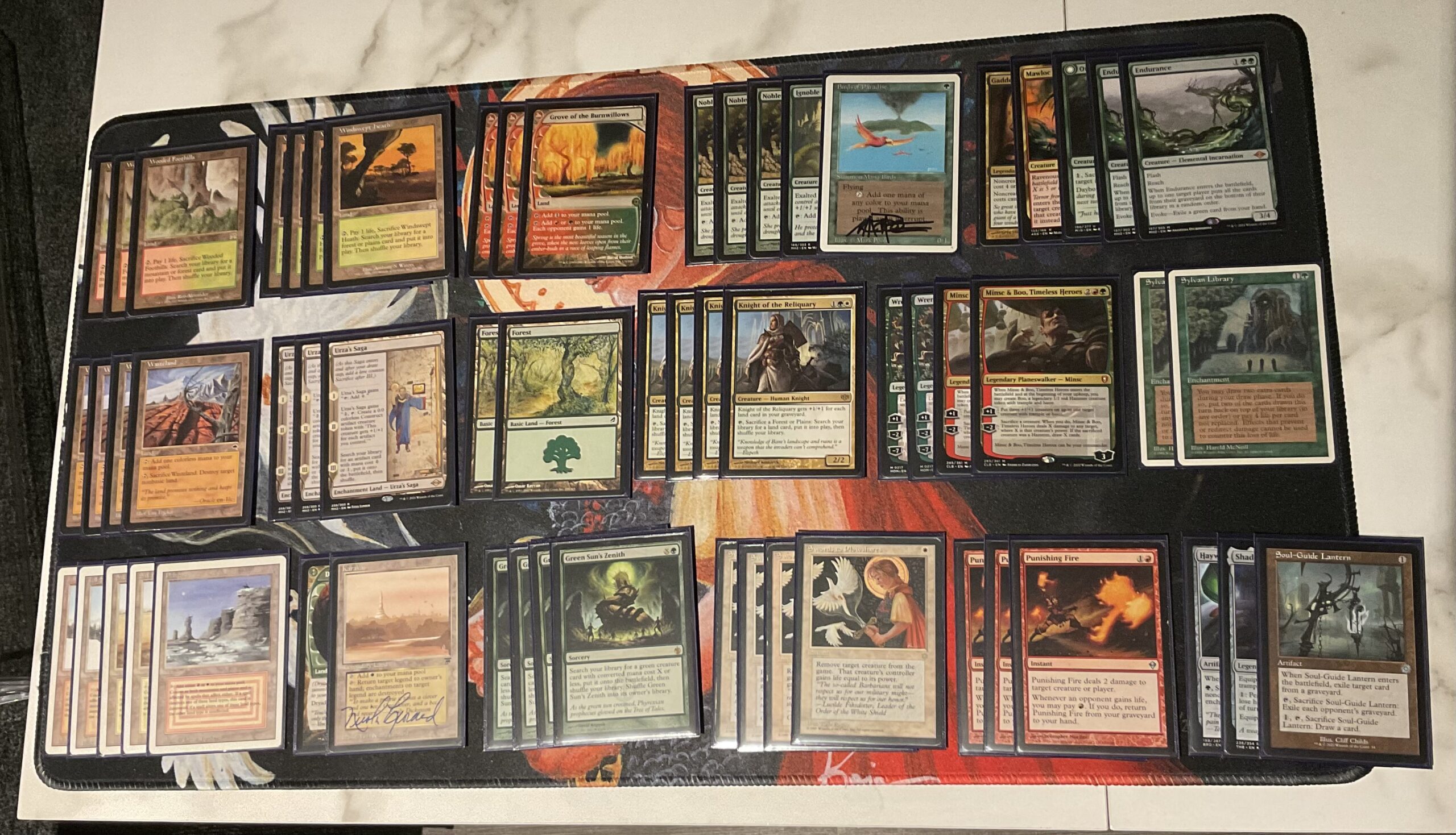
Punishing Maverick by Michael S

Punishing Maverick by Da_Miech

The Mark Strassman special
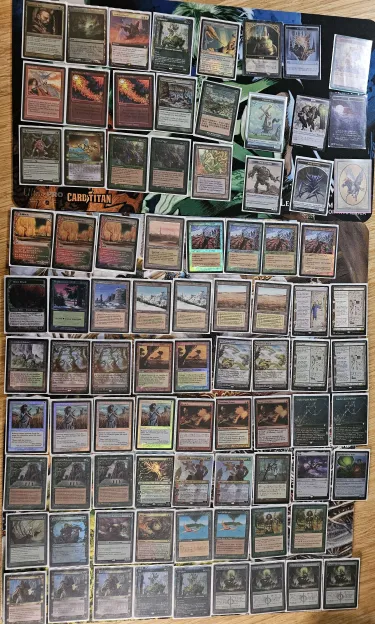
Other Resources
– Article | Punishing Maverick Guide / Sideboard Guide | February 2023
– Article | Eternal 101: Punishing Legacy
– Podcast | Leaving a Legacy Ep 107 | Punishing Maverick | October, 2016
– VOD | Mark Strassman (Punishing Maverick) vs Reid Duke (Elves) | SCG Baltimore 2017
– VOD Inside the Maverick | GWRx Maverick with Mark Strassman | August 2020
– Follow Mark on Twitch who streams Naya Maverick multiple times a week on Twitch
– Follow myself on Twitch as I also stream Naya Maverick!



